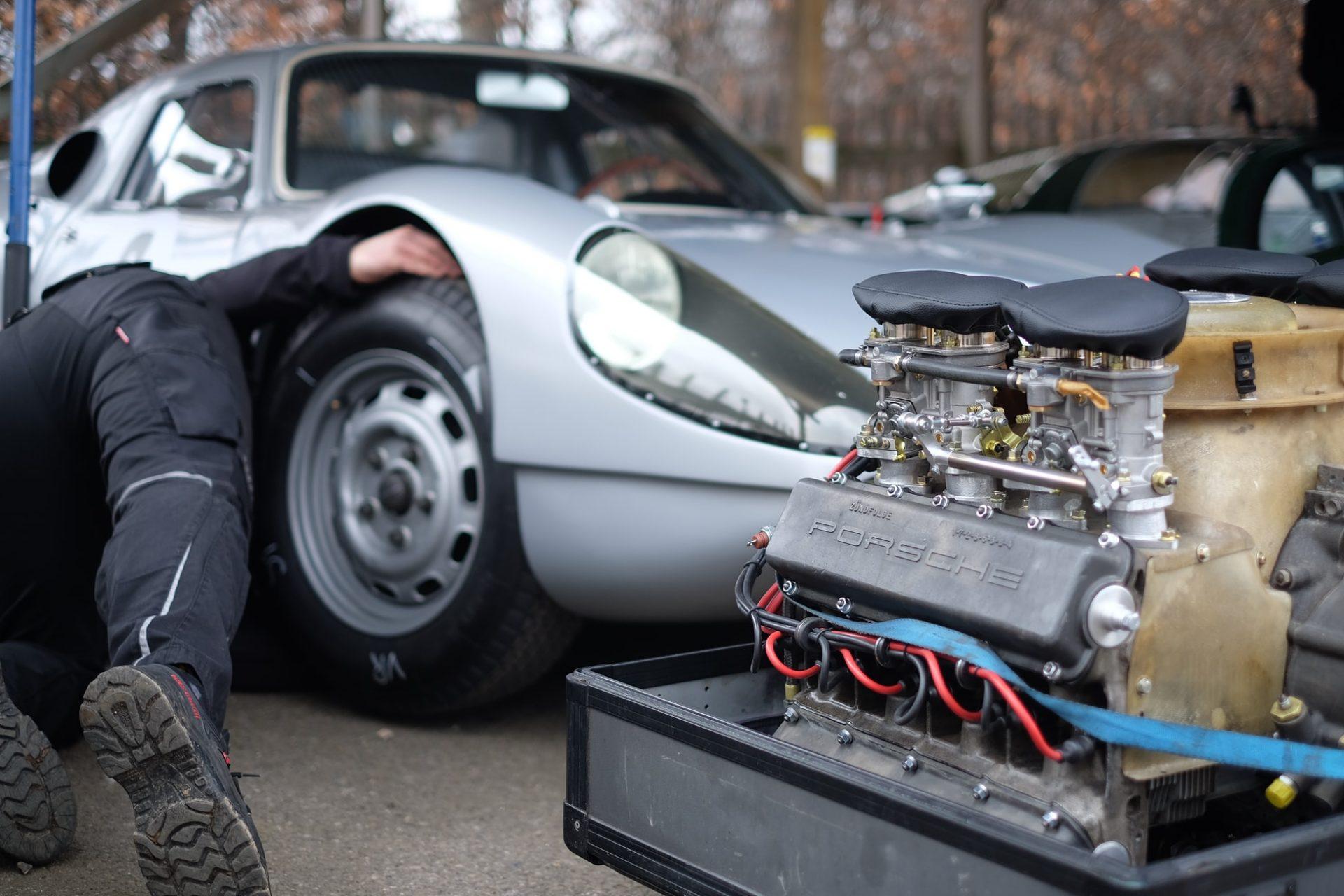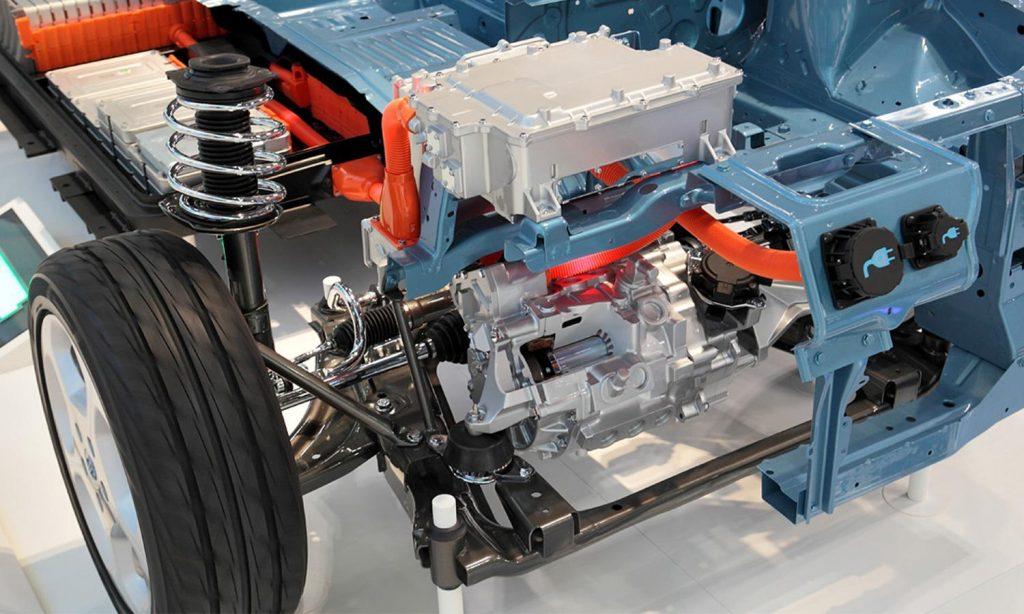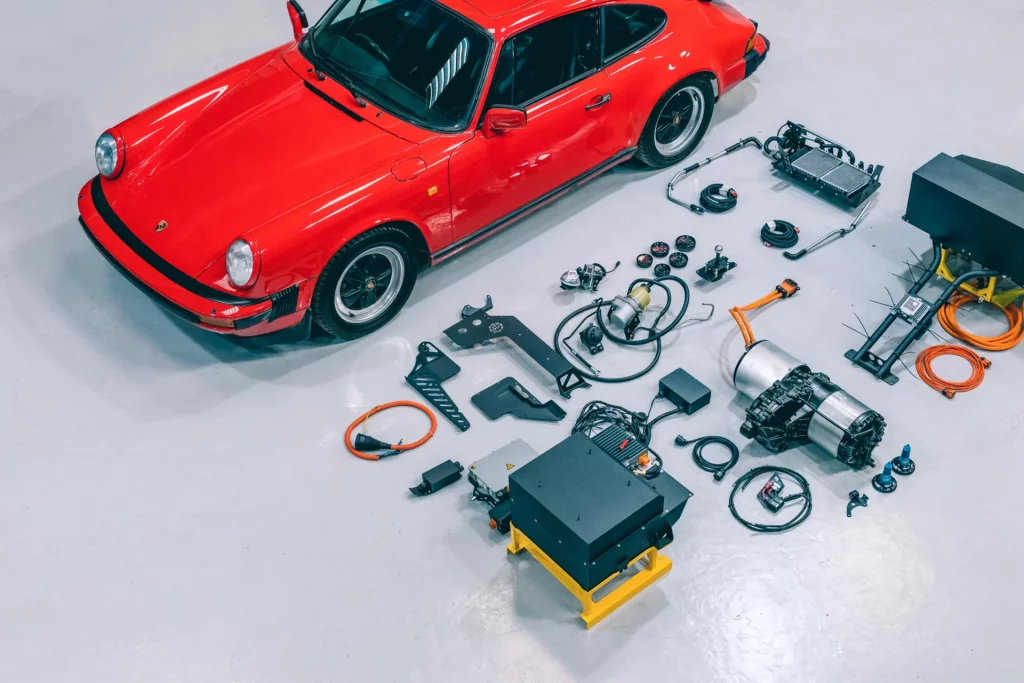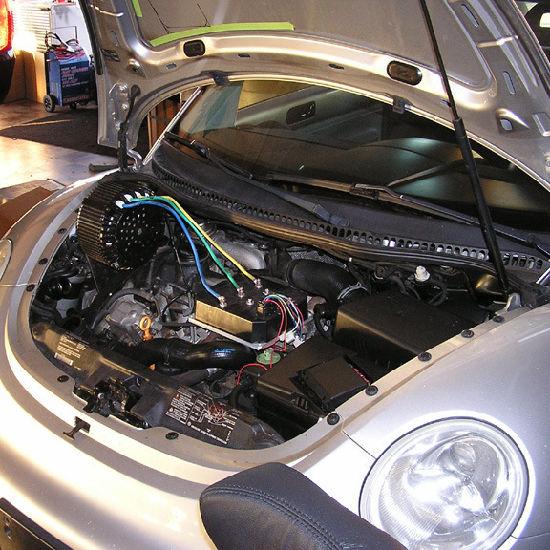Understanding EV Conversion Kits
By Sebastian Orellana
Updated Feb 17, 2024

Electric vehicles (EVs) are revolutionizing the automotive industry, offering a cleaner, more sustainable mode of transportation. As the demand for EVs grows, so does the interest in EV conversion kits. These kits allow car enthusiasts and environmentally conscious consumers to transform traditional gasoline-powered vehicles into electric ones.
Table of Contents
This article will delve into the world of EV conversion kits, exploring what they are, their importance, and their main components. We'll also guide you on choosing the correct conversion kit and provide insights into the installation and maintenance of converted electric vehicles.
READ: What is Needed to Convert a Car to Electric?
Unraveling the Intricacies of EV Conversion Kits

As society gravitates towards sustainable alternatives, electric vehicles (EVs) have become a viable and popular replacement for traditional combustion engine vehicles. This shift has spurred the emergence of a new market sector: EV conversion kits. These kits empower individuals to convert their gasoline-powered vehicles into fully operational EVs, offering a cost-effective and equally efficient option compared to purchasing brand-new electric cars.
This article delves into the world of EV conversion kits, exploring their essence, significance, and critical components. We'll also examine the differences between AC and DC conversion kits and guide on choosing the right kit for your vehicle. Finally, we'll illuminate the installation process and discuss how to maintain your newly converted vehicle to ensure it remains in peak condition.
This comprehensive guide will equip you with a thorough understanding of EV conversion kits, paving the way for your transition from gasoline-dependent to electric-powered transportation.
Decoding EV Conversion Kits
At their essence, EV conversion kits are specialized packages designed to replace a vehicle's gasoline-based engine system with an electric one. It's like giving your old car a brand new heart that pulses with high-performance electrons instead of fossil fuels. This transformation extends beyond just a change in propulsion method, encompassing a new set of system parameters, maintenance strategies, and a wholly revamped driving experience.
Investing in an EV conversion kit means purchasing a new powertrain for your vehicle. These kits comprise various components necessary for the conversion, including an electric motor to power your car, a controller to manage electricity flow from the battery to the engine, and power cabling to connect all components. Some kits may include additional hardware and software to facilitate a smooth conversion process.
One of the advantages of EV conversion kits is their versatility. They're not limited to specific vehicle types. Whether you own a compact car, a sedan, a large van, or even a classic car, if it's a conventional gasoline-powered vehicle, you can convert it into an electric vehicle using the suitable conversion kit. This flexibility provides many options for those looking to make the eco-friendly switch without investing in a new car.
Grasping the Significance of EV Conversion Kits
As we shift gears from conventional gas-powered vehicles to electric ones, the benefits are environmental and economic. EV conversion kits are a ticket to join this transition, offering a cost-effective way to contribute to a greener future. By swapping out the internal combustion engine for an electric powertrain, your vehicle's carbon emissions are eradicated, and the demand for fossil fuels decreases. This switch significantly reduces your carbon footprint, paving the way for a sustainable, unattainable lifestyle with gas-powered cars.
From a financial perspective, converting your current vehicle to electric using an EV conversion kit can be more cost-effective than purchasing a brand-new electric vehicle. While the initial investment may be substantial, the lower running costs make EV conversion worthwhile. Electric vehicles demand less maintenance and fewer parts replacements and operate on electricity, which is considerably cheaper than gasoline. Over time, lower running costs and maintenance savings can counterbalance the initial conversion cost.
EV conversion kits also bring new life into vintage cars and vehicles with sentimental or collector value. By replacing their outdated, polluting, and inefficient engines with powerful, clean electric powertrains, you can continue to enjoy these vehicles without the guilt and high operating costs. This process not only preserves automotive heritage but also aligns it with a future striving to be emission-free.
Deciphering the Key Components of EV Conversion Kits

EV conversion kits comprise several essential components that facilitate your vehicle's transformation from a gas-guzzler to an electric powerhouse. The most vital element is the electric motor, which replaces your internal combustion engine. This motor provides the necessary power to propel the vehicle. Two main types of motors are typically used: AC (Alternating Current) or DC (Direct Current) motors. While DC motors are more budget-friendly and straightforward, AC motors offer superior efficiency and regenerative braking capabilities.
The controller, another crucial component, is the intermediary between the motor and the vehicle's batteries. It regulates the energy flow from the battery pack to the electric motor, thereby controlling the vehicle's speed.
The battery pack, another key component, stores the electricity that fuels the motor. Most EV conversion kits use lithium-ion batteries due to their high energy density and efficiency. However, the size and capacity of the battery pack can vary based on the vehicle's specific needs and the desired driving range.
The kit may also contain other components such as a charger for recharging your battery, a DC converter for powering the vehicle's 12-volt accessories, a battery management system for monitoring and maintaining the battery pack's health, and various cables, connectors, and fittings necessary for the installation and operation of the electric system.
How to Select Ideal EV Conversion Kits
Converting your vehicle to electric involves a critical step: selecting the right EV conversion kit. Several factors will influence your choice, including your vehicle's type and weight, your desired driving range, and your budget. However, one factor that often goes unnoticed is the decision between AC and DC conversion kits. Each option has its own pros and cons, and understanding these is crucial to making an informed decision.
AC motors, for instance, offer superior efficiency and the added advantage of regenerative braking, a feature that uses the energy generated during braking to recharge the batteries. They also deliver enhanced performance in terms of acceleration and top speed. However, AC conversion kits can be more costly, both initially and in terms of installation, due to the need for a more complex controller and sometimes additional components.
Conversely, DC motors may be less efficient but are more affordable and simpler to install. With fewer moving parts, they require less maintenance. They also deliver high torque at low RPM, resulting in responsive acceleration from a standstill. However, DC systems are generally heavier and lack the regenerative braking feature, which can impact efficiency and driving range.
Therefore, selecting the right EV conversion kits involves balancing and aligning these factors with your specific needs and priorities. Seeking advice from an experienced EV conversion specialist can be invaluable in understanding these complexities and making the best choice for your unique vehicle and driving habits.
READ: Legal Requirements for EV Conversions
Exploring AC Conversion Kits
If you prioritize enhanced driving performance and efficiency, AC Conversion kits might be your superior choice. AC motors operate using alternating current, positively impacting their design and operation. They deliver better torque across various RPMs, resulting in smoother acceleration and higher speeds. This makes them more suitable for highway driving.
One of the key benefits of AC conversion kits is the feature of regenerative braking or regen. Regen allows the motor to function as a generator during deceleration, converting kinetic energy back into electrical energy. This energy is then used to recharge the battery pack, extending your electric vehicle's range.
Additionally, AC conversion kits are typically lighter than DC kits, reducing the vehicle's overall weight and further enhancing performance and efficiency. They also require less maintenance due to having fewer moving parts.
However, the intricacies associated with AC conversion kits mean they are generally more expensive. Combining the AC motor, AC controller, and additional components for the regen feature can increase the initial cost. Nevertheless, the long-term benefits of efficiency, performance, and maintenance often make AC conversion kits worthwhile.
Understanding Direct Current (DC) Conversion Kits

Direct Current (DC) conversion kits are famous for their simplicity and cost-effectiveness. These kits utilize a DC motor known for its straightforward design and operation. This makes them ideal for budget-conscious consumers or those who enjoy tackling 'DIY' projects. DC motors offer high torque at low RPMs, translating to powerful acceleration from a standstill. This makes them particularly suitable for city driving or situations requiring quick bursts of speed.
One of the advantages of a DC motor system is its relative simplicity compared to an Alternating Current (AC) system. This simplicity extends to the components of the system, which are less complex, thus reducing costs and making installation and maintenance more manageable. The fewer electrical connections in a DC system also minimize the risk of loose or faulty wiring, thereby reducing potential issues in the future.
However, DC conversion kits do have their drawbacks. One significant limitation is the absence of regenerative braking capabilities, which could lead to decreased efficiency and potentially shorter driving range compared to an AC system. Additionally, DC systems tend to be heavier, which may affect the vehicle's overall weight and handling.
Despite these limitations, DC conversion kits offer a cost-effective alternative to AC kits. They deliver respectable performance and meet the needs of many drivers, particularly those who primarily use their vehicles for short city commutes.
Installation and Maintenance of Converted Electric Vehicles
The next step is installation after choosing and purchasing your EV conversion kit. This involves removing the vehicle's internal combustion engine and other related components and replacing them with the parts from the EV conversion kit. The specifics of this process can vary greatly depending on your vehicle's exact model and the type of EV conversion kit you've chosen. It's important to note that if you decide to undertake this process yourself, you'll need a thorough understanding of your vehicle's mechanics and electrical systems. Alternatively, professional installation services are available.
Maintenance of a converted electric vehicle differs significantly from that of a traditional gasoline-powered car. Instead of regular oil changes, fluid top-ups, or spark plug replacements, EV maintenance primarily involves inspecting and maintaining the battery system, the electric motor, and other electronic components.
The battery's lifespan can depend on various factors, including the type of battery, driving conditions, and charging habits. Regular monitoring of the battery’s health can help identify potential issues early on. Similarly, while electric motors are known for their longevity and reliability, routine checks are advisable to ensure they're in good working order.
In conclusion, while installing and maintaining an EV may require learning new concepts and components, they can potentially reduce long-term maintenance costs and environmental impact while enhancing the overall driving experience. This makes it a worthwhile endeavor for any car enthusiast seeking a sustainable and high-performance alternative.
Installation Process
Transforming a traditional vehicle into an electric one with an EV conversion kit is a detailed yet fulfilling endeavor. The journey begins by removing the original internal combustion engine, fuel tank, exhaust system, and other parts. It may also be necessary to upgrade the braking and suspension systems to handle the weight and power of the new components.
The next step involves the fitting of the electric motor. This is connected to the existing transmission system using an adapter plate and a specially designed coupling, whether using an AC or DC motor. The kit's designer usually provides comprehensive instructions and specifications to ensure this step is executed correctly. Proper alignment and securement of the motor are vital to avoid potential issues down the line.
Another key aspect of the installation process is the battery system, which powers the electric motor. These batteries must be mounted securely in a spot that offers a balance of weight distribution, ease of access, and safety. Given the size, weight, and quantity of batteries in the conversion kit, they add significant weight to the vehicle, necessitating careful handling.
The final installation stage involves the controller unit, which regulates the power flow between the battery and the motor. This is usually mounted in the engine compartment and connected to the throttle, switch gears, and other relevant existing components. Depending on the kit, additional accessories such as a charger, gauges, or converters may also need to be installed.
While self-installation is possible, it requires a deep understanding of vehicle mechanics and electrical systems and a good dose of practical skills. If this seems daunting, professional installation services are a viable alternative.
READ: Do Electric Car Needs To Warm Up?
Vehicle Maintenance
Maintaining a converted electric vehicle differs significantly from a traditional combustion-engine vehicle. Due to fewer moving parts, a well-kept electric vehicle can outlive its petrol or diesel counterparts, resulting in fewer potential issues or wear and tear.
The battery pack is a primary component that requires regular maintenance in an EV. Keeping a close eye on the battery’s health can help detect problems early. A decline in vehicle performance or a noticeable reduction in the usual driving range could indicate that the batteries need attention. Depending on the battery type, periodic maintenance may be necessary to ensure peak performance and longevity.
Despite requiring less maintenance than combustion engines, electric motors still need occasional inspections. This includes checking for any loose connections or signs of wear and tear, and cleaning as accumulated dirt can cause the motor to overheat.
Regular check-ups are also necessary for the controller, the heart of your converted electric vehicle. This involves a visual inspection for signs of wear and tear, verifying all connections, and ensuring the cooling system (if present) is functioning correctly.
Like any other vehicle, converted electric vehicles also require routine vehicle maintenance such as tire rotation and alignment, brake checks, and regular suspension system inspections, particularly given the added weight from the conversion.
Adhering to these maintenance practices can help ensure your converted electric vehicle operates efficiently and has a long lifespan. With EVs generally requiring less maintenance than their petrol or diesel counterparts and no need for engine oil or transmission fluid changes, owning a converted EV can be a cost-effective and satisfying experience.
